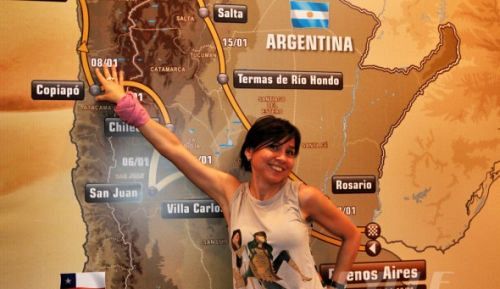Air conditioning is a given in the MotoGP press room, as well as wifi. The environment is immaculate, the garages even more, so you can even see your reflection. Certainly, switching from MotoGP to the Dakar Rally is a big change, even for us journalists.
Welcome to off-road, the world of heavily treaded tires, dust, and mud.
Universally recognized as the toughest rally in the world, the Dakar is a 2-week race covering over 5,600 miles. For the riders, this means waking up at 4:00 a.m., jumping on the bike at 05:00 a.m. in all kinds of weather, and eventually tackling the timed section of the race.
Things are not so different for the media and assistance teams. Most journalists travel in a media car, covering an average of 400 miles per day. The roads are mostly asphalt, so you can do it in a rental car, but a 4×4 is always preferable. Radio and TV reporters usually travel in a media plane.
In covering several Dakars, I’ve had the chance to travel both ways. Flying onboard military planes that leave from small airports in the middle of nowhere makes you feel like an action reporter. You don’t gain so much time in terms of sleep, but you arrive in the morning in the next bivouac ready to follow the race live on dakar.com, post your Twitter and Facebook feeds, and be the first to interview the riders when they arrive.
Personally I prefer to travel by car. The alarm goes off at around 4:30 a.m.. Time to wash your face and brush your teeth all rigorously with bottled water, take down your tent and run to the breakfast area. Then you hit the road. The goal is to arrive at the next bivouac in time for the first bikes. If you travel with experienced colleagues, the mission is accomplished. Plus you enjoy the scenery. Argentina and Chile are majestic. The people are nice. Every day is a new adventure. Even so, arriving safely and on time at the next bivouac, able to bring home the day’s work, is still an achievement.
Finding out that almost all of the petrol stations in Argentina are equipped with free wifi is a pleasant surprise; many times, the gasolineras turn into a field press room.
In the bivouac, the press room is like an oven, packed with photographers and journalists bathed in sweat. The wooden tables are covered with dust and sand is everywhere, especially when the camp is situated on a large dirt field. Only the media traveling by plane have reserved seats; all others have to squeeze in. If you’ve forgotten the cord to tie your computer to the leg of a table, you have to take shifts to go to the bathroom. Because the main rule is never leave your stuff unattended.
Getting an interview with the riders is quite easy. People are very easygoing, and it’s a pleasure to be invited for a camp aperitif “happy hour” with good wine, ham, and cheese, especially if the team is Spanish.
For dinner, a huge horseshoe-shaped catering tent serves around 80,000 meals throughout the two weeks of the rally. The food is good and your bracelet, which represents your credential, is equipped with a micro chip so that you can only eat once. Long gone are the old times when mechanics who had finished working at crazy hours could eat two or three times!
Before inflating your mat and taking shelter in your tent, it’s time for a quick visit to the showers. As a woman, I’m lucky, as we are not so many, especially at 10.00 p.m. The chemical toilets, on the contrary, remain a stumbling block. Every day, around 3,000 people attend the bivouac. I leave it to your imagination.
The best places to listen to fun stories are at dinner and in the proximity of the sinks, while you’re queuing to brush your teeth. It is here that you meet the usual clubbers. After 11:00 p.m, when the professional riders are already in bed, mechanics and the veterans emerge from their big trucks. You always end up talking about Africa. I listen. The Dakar Rally in Africa remains a forbidden dream, and it’s always nice to listen to the legendary stories of the good old times.
But the Dakar is the Dakar, and when it’s finished, you count the days until you come back.
Small Handbook: Bivouac Life
Little tricks to make the bivouac more comfortable.
1. Forget the compass, but never the smart phone.
2. When you erect your tent, mark it with a flag. When the elephants (the assistance trucks) arrive, you can spend hours looking for your tent.
3. Learn how to take down your tent quickly to avoid being left behind the next day.
4. Identify the best place to spend the night. My advice? Set up your tent away from the generators of trucks and racing cars…those guys usually work late into the night.
5. The password for entering the bivouac: Bracelet.
6. Take a shower as soon as you arrive at the bivoauc. Showers are still clean and you’re less likely to run out of water.
7. Get an internet modem with a local operator. The internet package in the press room costs $2,250 per 2,000 MB, or $22,500 for unlimited internet.
8-Have a credit card, because you need to pay for everything in advance to be part of the Dakar Rally. Getting a credential as a journalist that gives you access to the bivoauc costs $3,600, plus another $3,300 for a seat in a media car. If you travel in a media plane, the price goes up to almost $12,000.












24
Comment